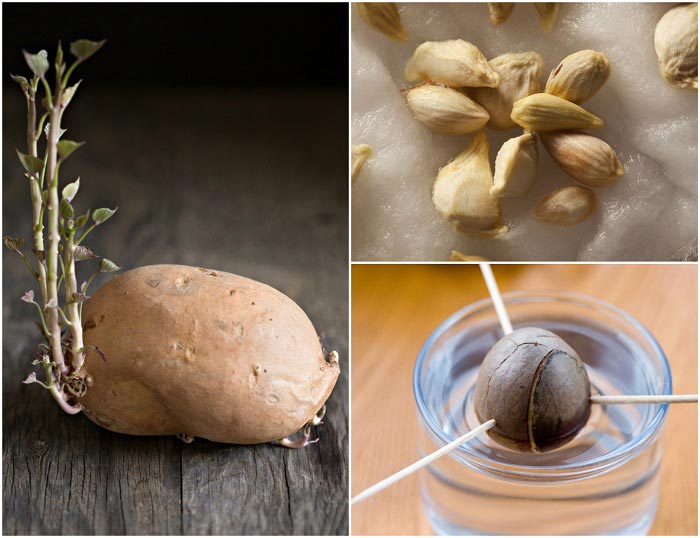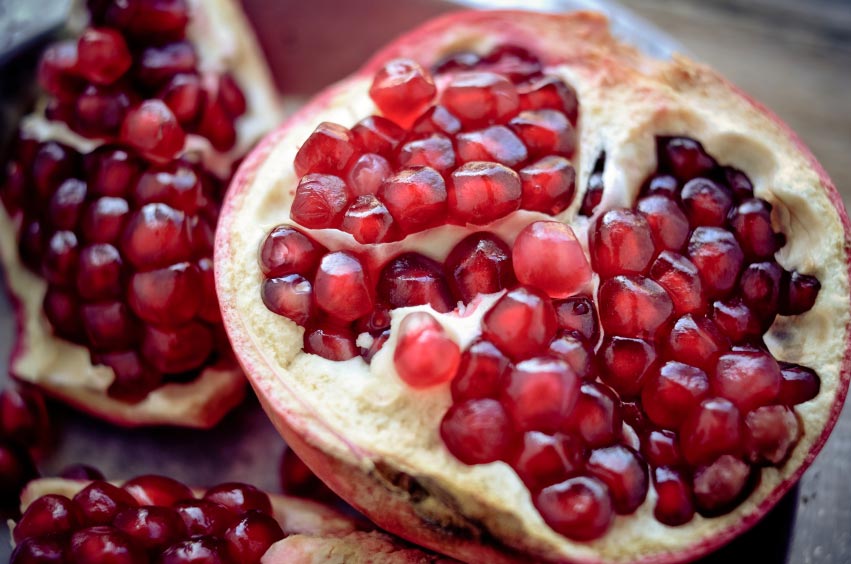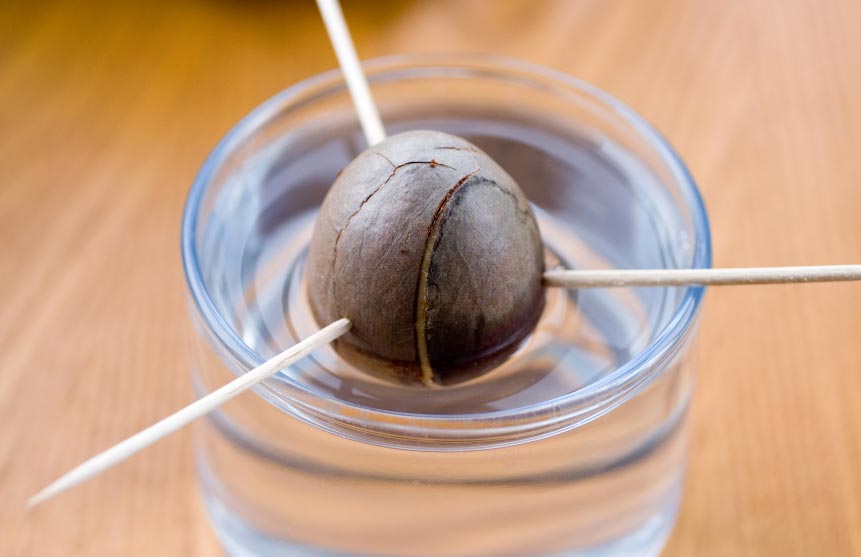
In addition to being lovely to gaze upon, houseplants can help make you smarter, happier, healthier, and more productive. While popular choices like aloe vera, spider plant, and golden porthos can be purchased inexpensively, do you know that you can grow handsome houseplants from produce you purchase from the grocery store? By using fruit and vegetable parts that are typically tossed away – seeds, pits, cuttings – you can cultivate visually-striking and unusual indoor plants, all for free. You’ll need an ample amount of patience for this project, but there is something so absolutely rewarding about nurturing a plant from dormant seed to thriving living organism.
Apple
Reaching a height of 25 feet outdoors, the apple tree can actually be grown in miniature in a container indoors or set out on a patio. While it’s best to source your seeds from a variety of apple that is grown locally or in similar climates, apples are “extreme heterozygotes” – their genetic makeup is combined randomly. This means that if you plant a seed from a Fuji apple, you might end up with a Gala tree. Keep in mind that apple trees are not self-pollinating, so your apple tree will likely never bear fruit.
- When the apple is ripe, cut it in half and harvest the seeds at its core with a sharp knife. The seeds need to be dry, so place them, spread apart, on a paper towel out of direct sunlight for a day or two.
- Apple seeds also require ‘after-ripening’, a period of dormancy in cool temperatures before they will germinate. Gather the seeds and place them in a sealable container, like a glass jar with a tight-fitting lid, and stow them in the refrigerator. Mark your calendar – they will need to stay put for 70 to 80 days.
- After the chill period has passed, it’s finally time to germinate. Enfold the seeds in moistened peat moss or paper towels, put it back in the container and return it to the fridge. Once a week, check the progress of the seeds and remoisten the growing medium as needed.
- When the seeds sprout taproots, which can take a month or more, it’s time to move them to sandy loam soil, roots facing down. A smaller pot will do for now but apple trees will eventually need a large container to grow in, a minimum of 18” – 22” in diameter with a volume of 11 to 16 gallons.
- Place in a warm location that receives full sun. Apple trees are thirsty beings, so check the soil moisture at least twice a week and even more frequently during hot spells.
Avocado
Normally growing to a height of 40 to 80 feet, avocado trees raised as houseplants can be dwarfed to three feet or less depending on the size of the container it grows in. With alternating elliptical leaves, avocado plants have an exotic look and can easily be grown from pit.
- Cut a ripe avocado in half and remove the pit. Wash the pit thoroughly to remove any avocado flesh.
- Using toothpicks, pierce the sides of the pit to suspend it over a glass of water, broad side down. One inch should be fully submerged in water. Place the glass in a warm spot out of direct sunlight. Top up the water every couple days and replace it with clean water when it looks murky.
- It can take two to eight weeks for the pit to crack, a taproot to form, and a stem to emerge from the top. When the avocado shoot is about six inches, cut it back to three inches to encourage more shoots to grow.
- Once the stem is six inches again, transfer the pit to a rich humus soil in a 10” planter, leaving the top part of the pit exposed. Set it in a sunny spot.
Citrus
Oranges, lemons, limes, grapefruit, tangerines, and kumquats are all good candidates for indoor planting. Exhibiting dark, glossy foliage, citrus plants may bloom sweet smelling flowers in the spring.
- Soak citrus seeds in warm water for 24 hours before planting in a sandy loam soil, a half inch deep, pointy ends of the seeds facing up. Water well and place the pot in a warm, dark location.
- To speed up germination, cover the pot with a plastic baggie to create a humidity tent.
- The first sprouts should pop up in two to six weeks. Remove the tenting and place in a spot that receives five to six hours of sunlight.
- As an ornamental, citrus trees should be pruned regularly to maintain a smaller stature.
Pineapple

Adding a touch of the exotic to your indoor spaces, pineapple plants have long pointed leaves that grow out from the center. Although it takes two or more years for a pineapple plant to mature, it could one day produce a stalk of blue-violet flowers, the beginnings of pineapple fruit.
- Pineapple is propagated by slicing off the crown, leaving an inch of the fruit intact. To prevent rot, carefully remove the outer flesh while preserving the tough, stringy core.
- The crown cutting should be set aside and air-dried for a couple days.
- Suspend the crown over a glass of water with toothpicks, as described above
- After a few weeks, roots will develop. Transfer the crown to a fine sandy loam soil with good drainage.
- Give it a good drink of water and place in a warm and sunny place. Cover with a humidity tent for about three weeks.
- The original crown leaves may begin to wither while new growths begin to emerge; this is normal, just remove any browning foliage.
Yams
Sweet potatoes sprout long, climbing vines with heart-shaped leaves, much like golden porthos. They are gorgeous trained along a trellis or potted in a hanging planter.
- Using the aforementioned toothpicks-and-glass-of-water trick, suspend the yam with its narrow end pointed down. Place the glass in a warm, bright spot out of direct light.
- In about 10 days, roots will materialize below and leafy shoots will start to form up top.
- After three weeks, when the roots and foliage look hardy, take it out of the water glass and plant in a sandy clay loam soil. Be sure to completely cover the original yam in soil.
Carrots
As a houseplant, carrots display delicate fern-like foliage with white flowers – quite similar to Queen Anne’s lace.
- Take a fresh carrot and cut it 1” – 3” from the top, and plant the orange portion in a compost soil mix while leaving the green stem exposed.
- For a bushier plant, use three or more carrots.
- The same procedure will also work with beets, parsnips, and turnips.
Dates
Date palms –what with their fibrous trunks and bluish-green fronds – make for a wonderful tropical floor plant. Only unpasteurized dates will be viable for home cultivation.
- Harvest the seeds from ripened dates and soak in water for one week to help soften the flesh, changing the water daily.
- Rinse the date seeds well. Wrap the seeds in a moistened paper towel and place in a zippered baggie. Set the bag in a warm spot away from direct light.
- Keep checking the roots and moisture every few days. Once the roots appear, plant them root down in potting soil. Add water and cover with humidity tent.
- When the first shoots emerge, remove the tent and put the pot in a sunny location.
Pomegranate

Dwarfed pomegranate plants are attractive indeed, with woody branches, slender oblong leaves, and blood orange blossoms that bloom in the summer.
- Extract the seeds from a ripe pomegranate, rinse them well to remove any flesh, and allow them to completely dry.
- Plant the seeds in potting soil, water well, and place in a sunny, warm location. Pomegranate seeds will germinate in about six weeks.
Dragon Fruit
Part of the cactus family, pitaya – or dragon fruit – grows long, triangular, fleshy stems. When in bloom, it produces large white or pink flowers.
- Dragon fruit can be propagated from those teeny-tiny black seeds in the center of the fruit. Collect these seeds and wash them thoroughly to remove the pulp.
- Sow seeds in sterile potting soil but only lightly cover the seeds in soil. Gently mist the soil with a spray bottle and cover with a humidity tent to hasten germination. Set the pot in a warm, bright place but keep it away from direct light.
- In two to four weeks, the cacti sprouts should emerge. Remove the tenting and place the planter in a warm place in full sun.
Recommended Reading: 12 Plants For Your Bedroom To Help You Sleep Better

